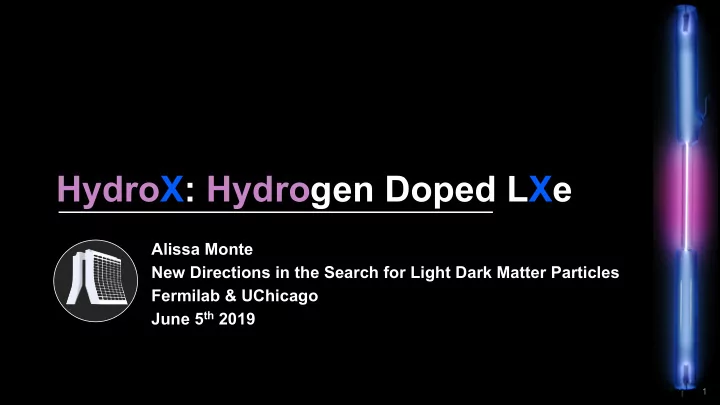

HydroX: Hydrogen Doped LXe Alissa Monte New Directions in the Search for Light Dark Matter Particles Fermilab & UChicago June 5 th 2019 1
Concept + G2 Xe TPCs: LZ, XENONnT, PandaX-4T Hydrogen dissolved in Xe: • S2/S1 discrimination between NR/ER • LXe is excellent solvent for light gases m χ > 8 GeV/c 2 (4 GeV/c 2 S2-only) • • Example: 2.6% mol fraction, ~2 kg H2 in LZ Self-shielding (1 MeV γ , 6 cm; 1 keV n, 9 cm) • • Better kinematic matching to low mass DM 2
Detection Techniques • Dissolve H2 in LXe • DM-H2 interactions: • DM scatters on H2 (proton) • Proton transfers energy to Xe (m H << m Xe ) • Little energy lost to elastic scatters on Xe, more interactions with Xe e - s: ~5x signal boost • Signals read out like any normal Xe TPC • PMTs are safe: H2 less problematic than He • Unclear whether H-recoils will have S2/S1 that is ER/NR/in-between-like LUX DD-calibration ER median NR median • Presence of H2 in the gas phase will negatively affect S2 gain, but allows higher extraction fields before breakdown • Garfield sims suggest 40 ph/e- achievable at 120% of the nominal LZ extraction field 3
Sensitivity Assumptions: • H2 in LZ environment • H2 mol fraction of 2.6%, 2.2 kg • S2/S1 is ER-like (no discrimination) • 250 live-day exposure 4
Proposed R&D Will it work at all? If it works, how do we calibrate it? If it works and we calibrate it, can we make it work in a G2 Xe TPC? 5
Proposed R&D Will it work at all? (XELDA test chamber at Fermilab) Measure Henry’s coefficient, H xp ∝ x/p • • Quantify effect of H2 concentration on S1 & S2 yield, S2 gain, and anode breakdown voltage • Preliminary Xe response to proton recoils Calibration? Development of a low energy neutron source (UCSB/NU) • keV Iron Neutron (keVIN) • 124 Sb- 9 Be source of 24 keV n , iron for γ attenuation and n E- selection, scandium conduit gives 1-2.5 keV n Can it work in a G2 Xe TPC? (cryogenic systems testing, Penn State) • Alternative purification (can’t use Zi getters) • Measure H2 diffusion in Xe. Requires forced convection? • Can we efficiently remove H2 from Xe? Follow up with larger scale circulation testing + low energy proton recoil calibration at SLAC 6
Future Prospects • H-doping gives new capabilities to existing Xe TPC (LZ, XENON, PandaX) • Take advantage of existing operations infrastructure • Xe self-shielding, not available in a conventional low mass experiment • Detector response and backgrounds will be well understood before H-run even starts! • Probe 100 MeV/c 2 – 5 GeV/c 2 DM masses, with SI and SD sensitivity 7
Backups 8
Deuterium • Only stable p-odd AND n-odd nuclide • Substitution of deuterium for H2 (with the same assumptions) shifts SI sensitivities down x4 and to the right by √2 • Provides sensitivity to SD DM-neutron interactions, sensitivity comparable to H2 SD interactions with a shift to the right by √2 • Plan to do deuterium measurements in parallel with H2 9
Dissolving H2 in LXe • Henry’s law: solute (H2) concentration in liquid (Xe) is proportional to partial pressure in the gas phase • Increased solubility of a gas in liquid is correlated with a deeper minimum in the Van der Waals potential (H2 is 3x that of He) • Xe is an efficient solvent because of its deeper VdW potential • Solubilities increase as a function of temperature • Extrapolation of existing measurements suggests 5% (2.6% conservative) H2 fraction is achievable 10
Iron/Scandium Transmission 11
XELDA 12
XELDA • MCNPX-Polimi simulation • Left: thermal neutrons • Right: simplified keVIN source • Due to XELDA’s size, can get mono-energetic source of 1.3 keV deuterium recoils from neutron capture on protons (gamma escapes) • Xe capture happens at higher rate, but has very low energy recoil • Endpoints 1 and 2 correspond to maximum energy recoils for SbBe: 24 keV (98%), 379 keV (2%) 13
Timeline • Jun 2020 – Operate Xe TPC with dissolved H2 • Mar 2021 – Measure >1 keV proton recoil yields • Dec 2021 – Demonstrate efficient injection/removal of H2 from Xe • Jan 2023 – Operation of H2-doped ~30 kg LXe TPC @ SLAC • Dec 2023 – Development of project plan and design report • 2025 – Tentative end of LZ science run 14
Recommend
More recommend